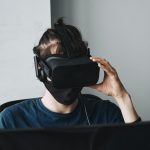Virtual Reality could be an extension of actual reality. Technologies like VR, AR and MR are grouped under the term XR (extended reality). They are an extension of our real world, bringing into our experience a world we have never seen before. Virtual reality consists of crafted simulations either of CGI’s (Computer generated imagery), or 360° videos that are shot in real life by people and put into perspective a slice of real life. ‘Presence’ is a term used in the virtual reality world where the user experiencing the VR feels present in the simulation making it feel like it’s ‘real’ to them. Having this gives the user a chance to engage all their senses while present in the VR headset, with their hearing, seeing and feeling all involved in the simulation, making the brain think it is a real experience.
The science behind this.
According to research, individuals are able to differentiate between stories read or heard and real-world events that occurred, but not so much when it comes to VR and the real world. This is due to the brain registering the events happening in VR as real events since it immerses and engages all the senses of the person, more importantly their physical movements and sense of presence.
This has a major advantage in order to experience things that are novel and out of reach in daily life. One of the biggest reasons VR technology is making a big mark in the training industry is that it helps the learner absorb and retain learning as a real event making it easier and more efficient. For individuals with learning disabilities that would find it hard to grasp training that comes in the written or lecture form, actually experiencing events and navigating responses makes it easier for them to grow and get better at attaining skills from the training.
How Real is Virtual ‘Reality’?
When it comes to putting the reality in VR, creators in VR are very mindful of making the presence of the user interactive and realistic. It is essential for a VR experience to be felt first person or POV (point of view) of the person. If the person were a bystander in their own simulation, it would be very different in the registration of their experience.
Users often have to pass levels in the virtual world, through focusing on what they are experiencing and how they react to stimuli. This is a big factor for making VR feel so real.
YesVR prides itself on making VR experience a memorable experience for the users. Reach out today to get a consultation and first-hand experience of an immersive VR training module.
Written by Simran Singh
Similar articles to check out:







